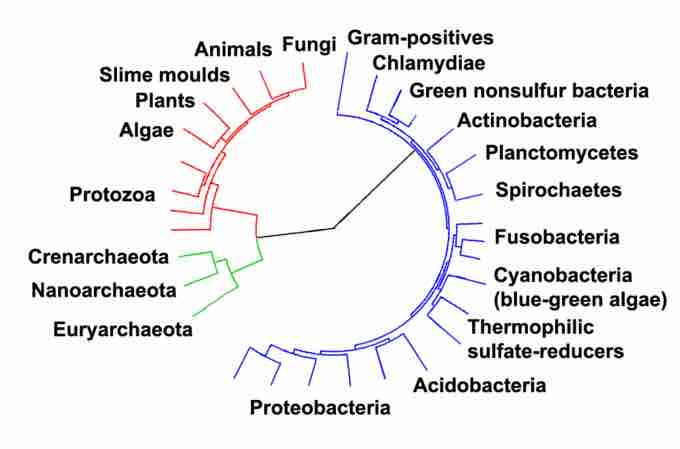The evolutionary relationship between archaea and eukaryotes remains unclear. Aside from the similarities in cell structure and function that are discussed below, many genetic trees group the two .

Archaea and other domains
Phylogenetic tree showing the relationship between the Archaea and other domains of life. Eukaryotes are colored red, archaea green and bacteria blue.
Complicating factors include claims that the relationship between eukaryotes and the archaeal phylum Crenarchaeota is closer than the relationship between the Euryarchaeota and the phylum Crenarchaeota, and the presence of archaean-like genes in certain bacteria, such as Thermotoga maritima, from horizontal gene transfer. The leading hypothesis is that the ancestor of the eukaryotes diverged early from the Archaea, and that eukaryotes arose through fusion of an archaean and eubacterium, which became the nucleus and cytoplasm. This explains various genetic similarities but runs into difficulties when it comes to explaining cell structure.
Despite this visual similarity to bacteria, archaea possess genes and several metabolic pathways that are more closely-related to those of eukaryotes, notably the enzymes involved in transcription and translation.
Archaea exhibit a great variety of chemical reactions in their metabolism and use many sources of energy. These reactions are classified into nutritional groups, depending on energy and carbon sources. Some archaea obtain energy from inorganic compounds such as sulfur or ammonia (they are lithotrophs). These include nitrifiers, methanogens and anaerobic methane oxidisers. In these reactions, one compound passes electrons to another (in a redox reaction), releasing energy to fuel the cell's activities. One compound acts as an electron donor and another as an electron acceptor. The energy released generates adenosine triphosphate (ATP) through chemiosmosis, in the same basic process that happens in the mitochondrion of eukaryotic cells.
The chromosomes replicate from multiple starting-points (origins of replication) using DNA polymerases that resemble the equivalent eukaryotic enzymes. However, the proteins that direct cell division, such as the protein FtsZ, which forms a contracting ring around the cell, and the components of the septum that is constructed across the center of the cell, are similar to their bacterial equivalents.